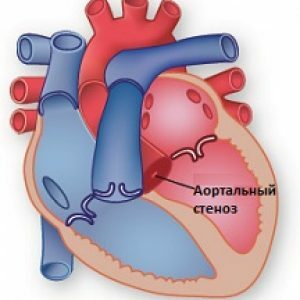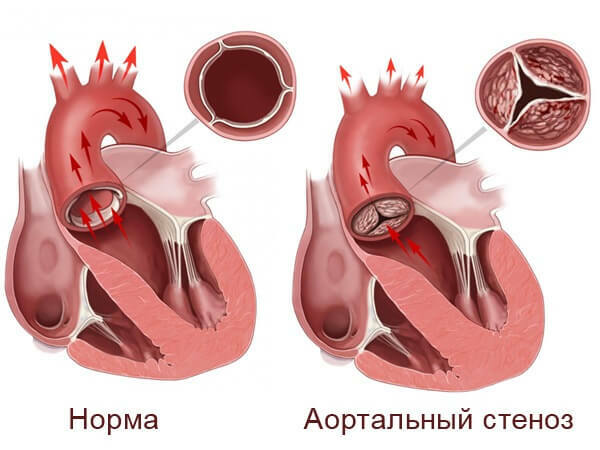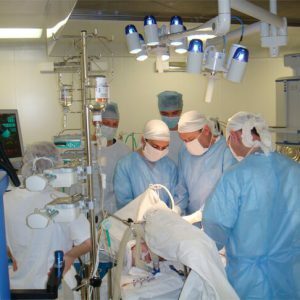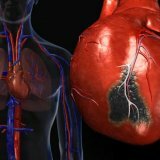Aortic stenosis
 Heart defects are diseases characterized by anatomical alteration of the valve apparatus or large vessels.Distinguish congenital( which are present in the child immediately at birth) and acquired( arising in vivo, due to the disease).
Heart defects are diseases characterized by anatomical alteration of the valve apparatus or large vessels.Distinguish congenital( which are present in the child immediately at birth) and acquired( arising in vivo, due to the disease).
Stenosis of the aortic aperture is one of the types of changes in the valve apparatus.In the presence of this defect, the valve flaps splice with each other, preventing normal blood flow.
As a result of aortic adhesions during systole( contraction), blood from the left ventricle of the heart hardly enters the aorta, because of this the muscle( myocardium) is significantly hypertrophied, and the left ventricle is stretched.
Table of contents: Stages and degrees of aortic stenosis Causes of aortic stenosis, risk factors Symptoms Complications Diagnosis of aortic stenosis Treatment of stenosis of aortic valves Prevention Special diet Features of aortic stenosis in children and pregnant womenStages and degrees of aortic stenosis

There are several degrees of severity of stenosis of the aortic aorta.They are determined by the area of opening the valve flaps at the time of systole and the pressure difference.
Note: The pressure gradient is a measure of the difference in pressure before and after the valve.Determined by ultrasound or cardiac catheterization.
Degrees of severity of aortic stenosis:
- degree ( minor stenosis) - the valve opening is not less than 1.2 cm2 and the gradient is 10 to 35 mmHg.
- II degree ( moderate stenosis) - the area of the valve opening is 1.2 - 0.75 cm2 with a pressure gradient of 36 to 65 mmHg.
- III degree ( severe stenosis) - the size of the valve opening does not exceed 0.74 cm2, and the gradient is greater than 65 mmHg. IV degree ( critical stenosis) - the constriction is 0.5 - 0.7 cm2, the pressure gradient is more than 80 mmHg.
You should also pay attention to the stages of stenosis, each of them has certain symptoms that help to establish the most accurate diagnosis.
Four stages of stenosis of the aortic orifice:
- Compensation is an asymptomatic period.The heart completely copes with the increase in the load, and the symptoms may not appear for several decades.
- Subcompensations - the first symptoms appear, mainly during heavy physical exertion, especially those that are unusual for the patient.
- Decompensation - severe and severe heart failure.Symptoms are manifested not only after minor loads, but also at rest.
- Terminal - due to complications and catastrophic changes in the heart and organs, death occurs.
Causes of aortic stenosis, risk factors
This acquired defect is most common in the elderly( 10 patients each).More than 80% of stenosis occurs due to age-related changes in valvular valve flaps( sclerosing), and 10% of cases are caused by rheumatic diseases of .The risk factor is also the presence of such a congenital developmental anomaly as a bicuspid aortic valve causing stenosis in a third of patients with this feature.
A separate role is played by heredity, bad habits, high cholesterol in the blood and arterial hypertension.
Symptoms of the disease
Symptomatic of diseases directly depends on how narrow the aortic aperture, that is, the degree of the disease.
I degree of aortic stenosis
This stage of the disease is characterized by a rather long asymptomatic course( more than 10 years). The most common pathology is found in surveys aimed at searching for other diseases or when undergoing medical examinations.After the detection of stenosis, the patient is placed on a dispensary account with a cardiologist who, with regular heart examinations( EchoCG), can monitor the development of the disease and schedule treatment in time, preventing the occurrence of complications.
Please note: all preparations are taken strictly according to the prescription of the doctor and after the appointment of the dosage you need, which corresponds with the degree and stage of the disease!
Surgery for aortic stenosis
 The surgical procedure is most effective in stenosis.The operation should be performed before the development of left ventricular failure, otherwise the likelihood of complications is high.
The surgical procedure is most effective in stenosis.The operation should be performed before the development of left ventricular failure, otherwise the likelihood of complications is high.
The operation is indicated for moderate to severe degree of stenosis or in the presence of clinical symptoms.Valvuloplasty( dissection of adhesions and adhesions in the valves) is performed with moderate stenosis.If the stenosis is severe, especially if it is associated with insufficiency, a more appropriate method of treatment will be a prosthetic repair of the damaged valve.
Prevention
Aortic stenosis is prevented by preventing diseases such as rheumatism, atherosclerosis, endocarditis, and maximum elimination of risk factors.
Special diet
Productive treatment of aortic stenosis is impossible without proper diet.
The following products should be excluded from the diet:
- excessively sharp, salty, smoked, fatty;
- "fast" food - hamburgers, shaurma;
- drinks with gas and desserts containing dyes;
- alcohol, smoking.
Note: despite the diet, the body needs a complex of vitamins and minerals.In this situation, the best yield will be synthetic complexes of vitamins.
Features of aortic stenosis in children and pregnant women
At the initial stage of the disease, the child behaves the same way as usual, and parents often do not consult a doctor.And minor symptoms: a small pallor, a bad sucking reflex and frequent regurgitation in babies do not suggest that you turn to a cardiologist.
During adolescence, the course of stenosis is similar to that in adults.
Pregnancy flow during stenosis of the aortic aorta
Due to the fact that pregnancy makes the heart work harder, with severe stenosis, abortion is shown, due to the high probability of death of the mother and child, and the risk of developing a congenital heart disease in a baby is more than 20%.
Both in the case of interruption, and in the case of retention of pregnancy, endocarditis is prevented by antibiotics.
Natalia Tavaluk, medical observer of



